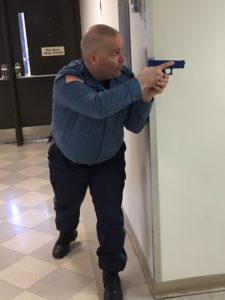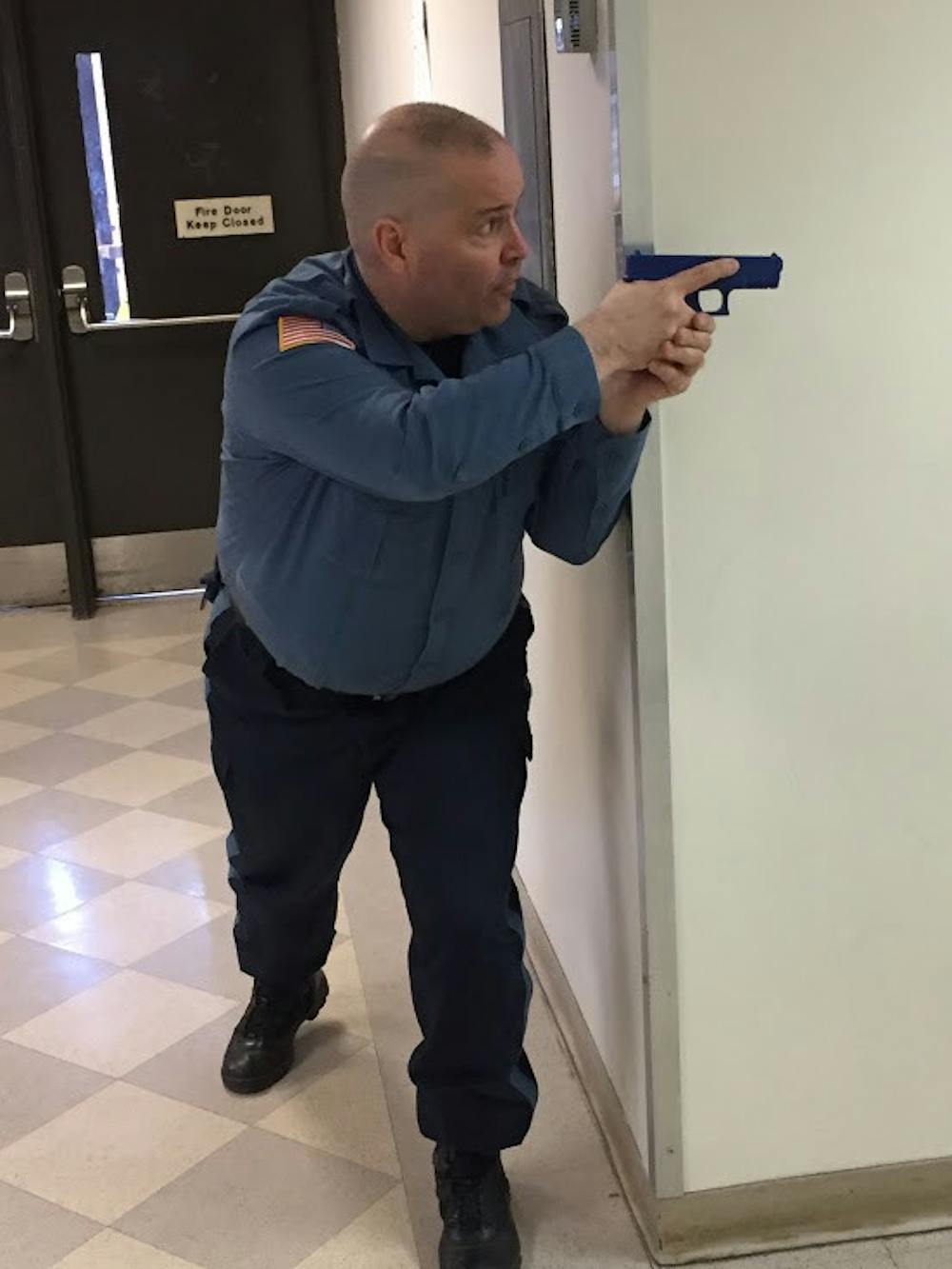By Brielle Bryan
Production Manager
A trail of red sticky residue lined the floors and walls of the Bliss Hall Annex as gunshots resonated throughout the building. Luckily, the guns fired contained simunition, or non-lethal ammunition that left behind a water-soluble, color-marking compound.
While most students spent their spring break skiing, lying on a beach or shoveling snow, Campus Police spent the break training its officers and preparing them for the possible scenario of an active shooter encroaching on the College’s property.
The training took place from March 13 to Friday, March 17, excluding March 14 due to a snowstorm.

Throughout the training course, Sgt. Bob Clement, one of the training officers, consistently stressed the importance of reaction time. Officers cannot afford to hesitate when entering a room with an active shooter.
“When violent physical assault becomes evident, selecting the appropriate course of action is very vital to the outcome,” Clement said. “It’s significant between life and death.”
Bill Straniero, assistant director to Campus Police, agreed.
“Every second you wait someone else can get killed,” he said.
Officers have about three-fourths of a second to get into a room and overwhelm an active shooter, according to Lt. James Lopez. This makes it even more important for the officer to get through the door fast and overpower the shooter.
The Law Enforcement Active Shooter Emergency Response course is a training course created by the Federal Emergency Management Agency that Lopez, Clement, Sgt. Scott Leusner and Sgt. Kevin McCullough are certified to teach. The mandatory training session is administered about once a year at the College.
The training officers not only stressed the ideas of staying alert and acting fast, but emphasized thinking ahead.
“It’s like a chess game,” Lopez said. “You have to be thinking a couple moves ahead.”
When entering a room with an active shooter, an officer has to be ready for multiple scenarios: the shooter could have a gun pointed at one or more hostages; the shooter could be hiding in the corners of the room or the victims could come running toward the door, distracting the officer from identifying the shooter.
“You have to be alert to everything around you,” Lopez said. “Whether you’re coming down the hall or making entry through the doorway, you’re always scanning and looking for where the threat is located.”
Officers were taught to respond to an incident in either a dynamic or covert manner.
According to Leusner, a dynamic operation is based on speed, surprise and force of action. This operation is executed when the officer hears the shots fired and can identify where they are coming from.

On the other hand, Leusner said a covert operation entails remaining undetected because the officer cannot be sure exactly where the shooter is located.
After going over the main concepts, the officers proceeded to participate in hands-on training exercises.
The first training exercise dealt with the way an officer and their partner should clear the stairwell when traveling to higher or lower floors in search of an active shooter.
The second focused on how to enter a doorway and get out of the “fatal funnel,” or the more vulnerable area of a room for an officer. The fatal funnel is the cone-shaped area of the room located at the door’s opening.
The last two training exercises consisted of the officers clearing a hallway and entering a room using a cross and hook technique.
After practicing the training exercises individually, the officers were then thrust into a simulation where they got to use fake ammunition to apprehend an actor playing an active shooter.
Some of the officers teaching the course took turns playing the roles of active shooter and victim, however, there were also student participants.
A few students volunteered to role play as the shooter or the victim.
Senior biology major Sabhya Gupta, a member of TCNJ EMS, volunteered. While her experiences as an EMT were very different than the exercises she observed that day with Campus Police, Gupta felt a new appreciation for the officers following her participation in the training course.
“As an EMT, we’re always told to stay back until the scene is safe and wait until (Campus Police) gets there,” Gupta said. “It makes me happy that we have such great people who are willing to put their lives at stake for us.”
Junior physical education major Tyler McGilligan also volunteered. Hoping to become a police officer himself, McGilligan found the training exercises and live simulation to be educational.
McCullough recorded the live simulations with his GoPro camera, which he played for everyone after the last live simulation. McCullough believes that it is important to watch oneself in action to see where they went wrong.
Leusner agreed.
“Mistakes will be made during training,” he said. “The goal is to be able to see where the weakness is so that it can be improved.”
Officer Kristen Albertson also emphasized the importance of improvement.
“Everyone’s perspective is different,” she said. “When given tips on how to make something better, it always helps.”
According to Lopez, the active shooter training course used at the College to train the officers is being adopted by all police agencies in Mercer County, N.J., as a way to standardize the police response to such incidents county wide.
With an abundance of mass shootings taking place around the nation, Campus Police are working to stay one step ahead.







